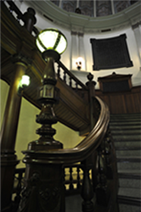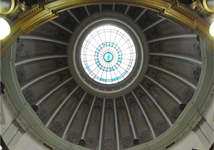Neoclassicism, a movement viewing the architecture of classical antiquity as embodying the aesthetic ideal, held sway throughout the West in the 18th and 19th centuries. It was both a reaction to what was perceived as the aesthetic incontinence of baroque architecture, which it supplanted, and a consequence of the growing fascination with archaeology, particularly the excavation of ancient ruins. In pursuit of its aesthetic ideal of harmony and balance, neoclassicism employed traditional styles and techniques to impressive effect.
Architects took their cues from the architectural styles of the Greco-Roman world. Numerous halls, museums, libraries, and so forth were constructed in which the architectural designs of classical antiquity were emulated with considerable accuracy.
Osaka Library, present-day Osaka Prefectural Nakanoshima Library, was completed in 1904 (37th year of the Meiji era). Faithfull to the tenets Greco-Roman temple architecture, this library is a fine example of the late flowering of neoclassicism in Japan.
One ascends to the stately portico, a porch leading to the main entrance at the front of the building, via 19-step stairs. The Corinthian capitals of the portico’s four columns support a large triangular pediment. The building is thought to be influence by libraries in the U.S. Indeed, in everything from its grand conception to its finest details, this splendid building has much in common with American neoclassicism.

 EN
EN












